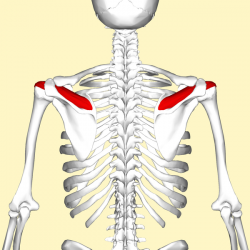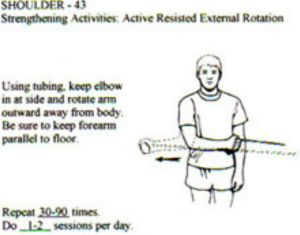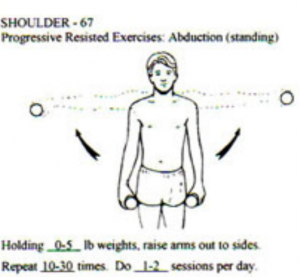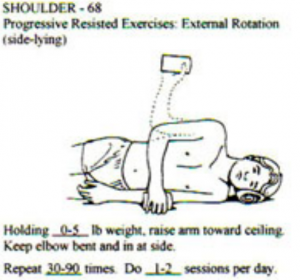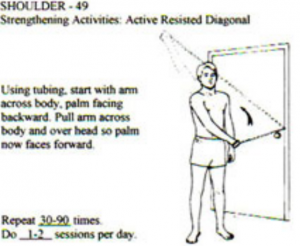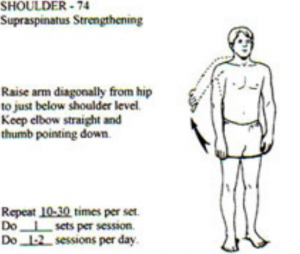Supraspinatus Tear: Difference between revisions
Leana Louw (talk | contribs) No edit summary |
Leana Louw (talk | contribs) No edit summary |
||
| Line 121: | Line 121: | ||
== Diagnostic procedures == | == Diagnostic procedures == | ||
=== Physical examination === | === Physical examination === | ||
* Subjective interview: | * Subjective interview: | ||
| Line 135: | Line 133: | ||
** Recreational or sport activities (possible overhead activities) | ** Recreational or sport activities (possible overhead activities) | ||
* Observation: | |||
** Any atrophy present | |||
* Range of motion: | * Range of motion: | ||
** Expect reductions in flexion, abduction and external rotation | ** Expect reductions in flexion, abduction and external rotation | ||
| Line 140: | Line 140: | ||
* Muscle power: | * Muscle power: | ||
** Test supraspinatus by resisting abduction at 90° and internal rotation | ** Test supraspinatus by resisting abduction at 90° and internal rotation | ||
* Palpation: | ** Scapular movement may be affected | ||
* Palpation: Forearm behind back to palpate rotator cuff just anterior and below the acromion | |||
** Muscle atrophy present | ** Muscle atrophy present | ||
** Tenderness | ** Tenderness | ||
* | |||
* Special tests: | |||
** Drop-arm test: Active shoulder abduction to 90°, then return <ref name=":4" /> | |||
*** Positive: Dropping the arm down with pain indicates a positive test | |||
** Jobe/supraspinatus/empty can test: Resist shoulder abduction and internal rotation<ref name=":4" /> | |||
*** Positive: Pain/weakness | |||
** Full can test: Resisted shoulder abduction in external rotation | |||
*** Positive: Pain/weakness | |||
** Subacromial grind test: Patient standing and examiner standing facing the patient, the examiner grasps the patient's flexed elbow. The shoulder is passively abducted in the scapular plane to 90°. The examiner's other hand is placed over the patient's shoulder overlying the anterior acromion and greater tuberosity. The examiner passively internally and externally rotates the shoulder detecting the presence of palpable crepitus. | |||
*** Positive: Palpable crepitus.<ref name=":12" /> | |||
<ref>Walters J, editor. Orthopaedics - A guide for practitioners. 4th Edition. Cape Town: University of Cape Town, 2010.</ref><ref name=":5" /> | |||
=== Special investigations === | === Special investigations === | ||
* '''[[X-Rays|X-rays]]:''' | * '''[[X-Rays|X-rays]]:''' | ||
| Line 150: | Line 163: | ||
** Unable to see tendon | ** Unable to see tendon | ||
* '''[[MRI Scans|MRI]]'''[[MRI Scans|:]] Shows partial or full tears in the tendons of the rotator cuff, inflammation to weak structures and cracks in the capsule | * '''[[MRI Scans|MRI]]'''[[MRI Scans|:]] Shows partial or full tears in the tendons of the rotator cuff, inflammation to weak structures and cracks in the capsule | ||
* '''[[CT Scans|CT scan]]''': Able to localize | * '''[[CT Scans|CT scan]]''': Able to localize tendon when patient positioned with forearm behind back | ||
* '''[[Ultrasound Scans|Ultrasound]]''': Able to localize tendon | * '''[[Ultrasound Scans|Ultrasound]]''': Able to localize tendon | ||
| Line 164: | Line 177: | ||
Position of the arm to be able to palpate the tendon to apply deep transverse friction or Ultrasound to the full width of the tendon: the shoulder should be rotated internally (forearm behind the back) so the supraspinatus tendon appears more in the frontal plane of the shoulder. | Position of the arm to be able to palpate the tendon to apply deep transverse friction or Ultrasound to the full width of the tendon: the shoulder should be rotated internally (forearm behind the back) so the supraspinatus tendon appears more in the frontal plane of the shoulder. | ||
Physical examination starts with inspection. Atrophy of the shoulder muscles is a common finding in patients with rotator cuff tears. The position and motion of the scapula is also important. The scapula rotates upward and downward during arm elevation/depression. This smooth movement of the scapula on the thorax may have deteriorated because of subacromial impingement or rotator cuff defect. For the purpose of identifying which tendon is ruptured, various location-specific physical examinations have been reported. A tear of the supraspinatus tendon can be detected by several tests.<ref name=":5">Orthop J. Rotator cuff tear: physical examination and conservative treatment | Physical examination starts with inspection. Atrophy of the shoulder muscles is a common finding in patients with rotator cuff tears. The position and motion of the scapula is also important. The scapula rotates upward and downward during arm elevation/depression. This smooth movement of the scapula on the thorax may have deteriorated because of subacromial impingement or rotator cuff defect. For the purpose of identifying which tendon is ruptured, various location-specific physical examinations have been reported. A tear of the supraspinatus tendon can be detected by several tests.<ref name=":5">Orthop J. Rotator cuff tear: physical examination and conservative treatment. Department of Orthopaedic Surgery Tohoku University, 2013:197–204.</ref> | ||
<sup></sup><br>The drop-arm test, active shoulder abduction to 90°, then return – dropping the arm down with pain indicates a positive test, produced a positive likelihood ratio above 10 or a negative likelihood ratio below 0,1 in two evaluations, but other studies are doubting the test.<ref name=":4">Hughers PC, Taylor NF, Green RA. Most clinical tests cannot accurately diagnose rotator cuff pathology: a systematic review. Aust J Physiother | <sup></sup><br>The drop-arm test, active shoulder abduction to 90°, then return – dropping the arm down with pain indicates a positive test, produced a positive likelihood ratio above 10 or a negative likelihood ratio below 0,1 in two evaluations, but other studies are doubting the test.<ref name=":4">Hughers PC, Taylor NF, Green RA. [https://ac.els-cdn.com/S0004951408700229/1-s2.0-S0004951408700229-main.pdf?_tid=8b887d9e-8135-4347-a25d-3c50c63efd54&acdnat=1535600075_4f552aaa403df67a5cac32ef4184113d Most clinical tests cannot accurately diagnose rotator cuff pathology: a systematic review.] Aust J Physiother 2008;54(3):159-70.</ref><br>The empty can test (also know as the supraspinatus test or Jobe test), resisted shoulder abduction in internal rotation, demonstrated diagnostic accuracy only once in 21 evaluations across six studies. Kim et al. reported a negative likelihood ratio of 0,03 using pain or weakness as a criterion, with full or partial thickness tears. <ref name=":4" /><br>The full can test, resisted shoulder abduction in external rotation, demonstrated a lack of diagnostic accuracy, using pain and/or weakness as criteria. <br>Investigating palpation of the supraspinatus tendon for a tendon rupture reported high sensivity values (and specifity) thus producing the most accurate result reported in the review. With a LR+of 29,91 and a LR- of 0,04.<ref name=":4" /><br>Another test is the subacromial grind test, With the patient standing and examiner standing facing the patient, the examiner grasps the patient's flexed elbow. The shoulder is passively abducted in the scapular plane to 90° (Hawkins-Kennedy test position) The examiner's other hand is placed over the patient's shoulder overlying the anterior acromion and greater tuberosity. The examiner passively internally and externally rotates the shoulder detecting the presence of palpable crepitus. The test was considered positive if resulted in palpable crepitus.<ref name=":12">Sawalha S, Fischer J. The accuracy of “subacromial grind test” in diagnosis of supraspinatus rotator cuff tears. International journal of shoulder surgery 2015;9(2):43-46.</ref> | ||
== Medical management == | == Medical management == | ||
Revision as of 05:37, 30 August 2018
Original Editor - Brecht Haex
Top Contributors - Leana Louw, Kim Jackson, Mats Vandervelde, Brecht Haex, Fasuba Ayobami, Vidya Acharya, Saimat Lachinova, Habibu Salisu Badamasi, Wendy Walker, Naomi O'Reilly, Joao Costa, Shreya Pavaskar, Simisola Ajeyalemi, Wout Van Hees, Wanda van Niekerk, Rachael Lowe and Anthony Mertens
This article is currently under review and may not be up to date. Please come back soon to see the finished work! (23 May 2024)
Definition/Description[edit | edit source]
A supraspinatus tear is a tear or rupture of the tendon of the supraspinatus muscle. The supraspinatus is part of the rotator cuff of the shoulder. Most of the time it is accompanied with another rotator cuff muscle tear. This can occur in due to a trauma or repeated micro-trauma and present as a partial or full thickness tear.[1] Most of the time the tear occurs in the tendon or as an avulsion from the greater tuberosity[2].
Clinical relevant anatom[edit | edit source]
The shoulder joint is made up of three bones: the humerus, scapula and clavicle. The head of humerus and glenoid of the scapula form a ball-and-socket joint[1]. The supraspinatus muscle is located on the back of the shoulder, forming part of the rotator cuff. The rotator cuff consists of Supraspinatus, Infraspinatus, Subscapularis and teres minor. The rotator cuff covers the head of the humerus and keeps it into place. These muscles help to lift and rotate the arm. Also see the page for the shoulder for more detailed information.
Supraspinatus[edit | edit source]
- Origin: Supraspinous fossa of the scapula
- Insertion: Greater tubercle of the humerus
- Innervation: Supraspinatus nerve (C5-C6)
- Function: Abduction of the glenohumeral joint; assists the rotator cuff in stabilizing, control and movement the shoulder; assists in preventing sublaxation at the shoulder
Epidemiology/Etiology[edit | edit source]
The etiology of supraspinatus tears is multifactorial, consisting of age-related degeneration, microtrauma and macrotrauma. The incidence increases with the age to about 50% during the 80s, mostly affecting the dominant arm.[5][6] Injury and degeneration are the two main causes of rotator cuff tears. Rotator cuff tears are associated with older patients, a history of trauma and mostly affect the dominant arm. The most common risk factors for a tear consist of a history of trauma, dominant arm and age.
Mechanism of injury[edit | edit source]
- Acute tear: Can occur with other shoulder injuries (e.g. clavicle fracture of shoulder dislocation)
- Fall on your outstretched arm
- Heavy lifting something too heavy
- Degenerative: Wear and tear of the tendon slowly over time
- Increases with the age
- More common in the dominant arm
- When you have a degenerative tear in one shoulder, you have a greater risk for a tear in the opposite shoulder, even if you have no pain in the opposite shoulder.
Risk factors[edit | edit source]
- > 40 years old
- Male > Female
- Smoking
- Genetics
- Hypercholesterolemia
- Body mass index
- Height
- Repetitive stress/lifting
- History of trauma
- Lack of blood supply
- Bony spurs
- Overhead activities and other people who do overhead work:
- Tennis players
- Baseball pitchers
- Painters
- Carpenters
- Plumbers
- Traumatic injury e.g. fall (more common cause in younger individuals)
Characteristics/Clinical presentation[edit | edit source]
Supraspinatus tears normally present as partial or full-thickness tears. The can be asymptomatic or symptomatic.
- Partial thickness: Incomplete disruption of muscle fibers[1]
- Can progress to complete tear - Increasing pain is normally the first sign of progression of a tear
- Full thickness: Complete disruption of muscle ibers
- Large tears (1-1,5cm) have high rate of progression
- If progression is suspected in conservatively managed cases - further investigation is warranted
- Smaller tears (<1cm) progress slower
Signs & symptoms[edit | edit source]
Patients normally present with:[1][6][7]
- Pain/worsening pain (in cases where tears are progressing): Most common symptom
- Pain when lifting and lowering your arm or with specific movemen
- Pain at rest
- Pain at night, predominantly when you lie on the affected shoulder
- Traumatic tears: Sudden, intense pain often accompanied by a snapping sensation and immediate weakness in the upper arm
- Located anterolaterally and superiorly
- Referred to the level of the deltoid insertion with full-thickness tears
- Repetitive strain tear: Starts off mild and only when lifting your arm; over time the pain can become more noticeable at rest
- Aggravated in overhead or forward-flexed position
- Limited range of motion:
- Reduced forward elevation, external rotation and abduction
- Struggle with activities like reaching behind back, combing hair and overhead activities
- Weakness when rotating or lifting your arm
- Crepitus
- Clicking
- Stiffness
- Limited range of motion:
- Reduced forward elevation, external rotation and abduction
- Struggle with activities like reaching behind back, combing hair and overhead activities
- Instability
Differential diagnosis[edit | edit source]
- Acromioclavicular joint injury
- Brachial plexus injury
- Bicipital tendinopathy
- Cervical radiculopathy
- Cervical spine sprain
- Cervical strain injuries
- Cervical disc injuries
- Cervical nerve root injury
- Cervical Spondylosis
- Cervical discogenic pain syndrome
- Clavicular fracture
- Sternoclavicular joint disorders
- Infraspinatus syndrome
- Contusions
- Rotator cuff tear
- Shoulder dislocation
- Myofascial pain
- Shoulder impingement syndrome
- Superior labrum lesions
- Shoulder subluxation
- Angina pectoris
- Myocardial infarction
- Subacromial impingement
- Osteoarthritis
- Rheumatoid arthritis
- Subscapular nerve entrapment
- Shoulder instability
Diagnostic procedures[edit | edit source]
Physical examination[edit | edit source]
- Subjective interview:
- Onset: Spontaneous or after injury
- Duration of pain
- Pain provocation/aggravating factors
- Night rest
- Same problems in the past?
- Activity limitations
- Localize pain
- Past medical history
- Recreational or sport activities (possible overhead activities)
- Observation:
- Any atrophy present
- Range of motion:
- Expect reductions in flexion, abduction and external rotation
- If passive abduction range is more than active range, it is an indication of a rotator cuff tear
- Muscle power:
- Test supraspinatus by resisting abduction at 90° and internal rotation
- Scapular movement may be affected
- Palpation: Forearm behind back to palpate rotator cuff just anterior and below the acromion
- Muscle atrophy present
- Tenderness
- Special tests:
- Drop-arm test: Active shoulder abduction to 90°, then return [10]
- Positive: Dropping the arm down with pain indicates a positive test
- Drop-arm test: Active shoulder abduction to 90°, then return [10]
- Jobe/supraspinatus/empty can test: Resist shoulder abduction and internal rotation[10]
- Positive: Pain/weakness
- Full can test: Resisted shoulder abduction in external rotation
- Positive: Pain/weakness
- Subacromial grind test: Patient standing and examiner standing facing the patient, the examiner grasps the patient's flexed elbow. The shoulder is passively abducted in the scapular plane to 90°. The examiner's other hand is placed over the patient's shoulder overlying the anterior acromion and greater tuberosity. The examiner passively internally and externally rotates the shoulder detecting the presence of palpable crepitus.
- Positive: Palpable crepitus.[11]
- Jobe/supraspinatus/empty can test: Resist shoulder abduction and internal rotation[10]
Special investigations[edit | edit source]
- X-rays:
- Exclude sclerosis and osteophyte formation on the acromion
- Measure the size of the subacromial space
- Unable to see tendon
- MRI: Shows partial or full tears in the tendons of the rotator cuff, inflammation to weak structures and cracks in the capsule
- CT scan: Able to localize tendon when patient positioned with forearm behind back
- Ultrasound: Able to localize tendon
Outcome measures[edit | edit source]
A wide variety of outcome measures have been used to evaluate the efficacy of Rotator Cuff (RC) treatments by assessing changes in patient function over the study period. The majority of scales used in the RC literature are disease-specific questionnaires developed for the assessment of the shoulder; however, generic scales (e.g., SF-36=non specific; QoL measure?) have also been used. The scales can broadly be classified into health-related quality of life and functional outcome measures. Health-related quality scales are developed with the intent of assessing patients‘ perception of the impact of their condition on their physical, social, psychological/emotional, and cognitive state. Functional outcome measures evaluate a patient‘s ability to perform activities of daily living and frequently incorporate clinically assessed components, such as range-of-motion or strength.[14]
Three health-related quality of life measures were used in the studies reviewed in this report: the Rotator Cuff Quality of Life (RC-QOL) scale, the Short-Form-36 (SF-36) and the Western Ontario Rotator Cuff (WORC) index. These self-reported scales assess similar domains, such as pain, physical symptoms, social and emotional functioning. The RC-QOL and SF-36 are scored on a scale of 0 to 100 points, where higher scores indicate better quality of life, while the WORC Index provides a score of up to 2,100 points with higher scores indicating poorer outcomes. There is evidence to support the reliability and convergent validity of each of the scales.[14]
About the DASH
The Disabilities of the Arm, Shoulder and Hand (DASH) Outcome Measure is a 30-item, self-report questionnaire designed to measure physical function and symptoms in patients with any or several musculoskeletal disorders of the upper limb.The questionnaire was designed to help describe the disability experienced by people with upper-limb disorders and also to monitor changes in symptoms and function over time. Testing has shown that the DASH performs well in both these roles.It gives clinicians and researchers the advantage of having a single, reliable instrument that can be used to assess any or all joints in the upper extremity.The DASH Outcome Measure contains two optional, four-item modules intended to measure symptoms and function in athletes, performing artists and other workers whose jobs require a high degree of physical performance. Because they may be having difficulties only at high performance levels–which are beyond the scope of the 30-item DASH Outcome Measure–clinicians may find the modules, which are scored separately from the DASH, useful in assessing these special patients.
DASH and QuickDASH Scoring Formula = ([(sum of n responses)/n] -1)(25) where n represents the number of completed items.
• DASH cannot be computed if greater than three items are missing[1].
• QuickDASH cannot be computed if greater than 1 item is missing.[1]
Level of Disability
In both the DASH and QuickDASH a higher scores indicate a greater level of disability and severity, whereas, lower scores indicate a lower level of disability. The score on both test ranges from 0 (no disability) to 100 (most severe disability). The Minimal Detectable Change (MDC= the smallest amount of change that has to occur before the change can be considered a true change and not error) for the DASH is 12,75-17,23%.
The Minimal Clinical Important Difference (MCID= the amount of change in the score that has to occur before it signifies an important or beneficial difference in the patient’s condition) is 10.83 points for the DASH[15].
DASH (http://www.dash.iwh.on.ca/scoring)[16]
ICC: 0.96 [13] Cronbach alpha: 0.97
- Quick DASH (http://www.dash.iwh.on.ca/scoring)
ICC: 0.94 [13] Cronbach alpha: 0.94
- Penn Shoulder Score: to measure outcome of patients with various shoulder disorders
ICC: 0.94 [14] Cronbach alpha: 0.93 ]
- Global Rating of Change Scale: to measure improvement
ICC: 0.74
Clinical examination[edit | edit source]
Position of the arm to be able to palpate the tendon to apply deep transverse friction or Ultrasound to the full width of the tendon: the shoulder should be rotated internally (forearm behind the back) so the supraspinatus tendon appears more in the frontal plane of the shoulder.
Physical examination starts with inspection. Atrophy of the shoulder muscles is a common finding in patients with rotator cuff tears. The position and motion of the scapula is also important. The scapula rotates upward and downward during arm elevation/depression. This smooth movement of the scapula on the thorax may have deteriorated because of subacromial impingement or rotator cuff defect. For the purpose of identifying which tendon is ruptured, various location-specific physical examinations have been reported. A tear of the supraspinatus tendon can be detected by several tests.[13]
The drop-arm test, active shoulder abduction to 90°, then return – dropping the arm down with pain indicates a positive test, produced a positive likelihood ratio above 10 or a negative likelihood ratio below 0,1 in two evaluations, but other studies are doubting the test.[10]
The empty can test (also know as the supraspinatus test or Jobe test), resisted shoulder abduction in internal rotation, demonstrated diagnostic accuracy only once in 21 evaluations across six studies. Kim et al. reported a negative likelihood ratio of 0,03 using pain or weakness as a criterion, with full or partial thickness tears. [10]
The full can test, resisted shoulder abduction in external rotation, demonstrated a lack of diagnostic accuracy, using pain and/or weakness as criteria.
Investigating palpation of the supraspinatus tendon for a tendon rupture reported high sensivity values (and specifity) thus producing the most accurate result reported in the review. With a LR+of 29,91 and a LR- of 0,04.[10]
Another test is the subacromial grind test, With the patient standing and examiner standing facing the patient, the examiner grasps the patient's flexed elbow. The shoulder is passively abducted in the scapular plane to 90° (Hawkins-Kennedy test position) The examiner's other hand is placed over the patient's shoulder overlying the anterior acromion and greater tuberosity. The examiner passively internally and externally rotates the shoulder detecting the presence of palpable crepitus. The test was considered positive if resulted in palpable crepitus.[11]
Medical management[edit | edit source]
Larger symptomatic full-thickness tears ( > 1cm -1,50 cm )have a high rate of progression and should be considered for earlier surgical repair in younger patients if the tear is repairable and the muscle degeneration is limited. This is important to avoid irreversible changes to the cuff. A nonoperative treatment can be used in older patients ( older than 70 years ) who have a chronic tear, in patients with irreparable tears with irreversible changes, in patients of any age with small (<1 cm) full-thickness tears or in patients without a full-thickness tear. An operative treatment can be used in acute tears (>1 cm-1.5 cm) or young patients with full-thickness tears who have a significant risk for the development of irreparable rotator cuff changes[5][6].
Smaller symptomatic <1cmfull-thickness tears ( < 1 cm ) and partial – thickness tears have a slower rate of progression and can be treated with a nonoperative treatment. This consists of NSAID’s like ibuprofen, injections with corticosteroids and a surgical treatment. The corticosteroid injections cannot heal the tear but in some cases it can make the tear painless for a period of time in which the patient is capable of undergoing physical therapy more easily. However the tendon tissue can be weakened by these injections which would have an adverse effect on the outcome of a possible surgery, therefore one should not get more than 2 injections.[17] When an injection is chosen it will be placed in the sub-acromial space as seen below.
These treatments are conservative medical treatments, if these and physical therapy (see below) don’t work the patient will have to undergo surgery.
The operative treatment is done mostly arthroscopically which is less invasive (than open/mini-open surgery) and leaves only a few small scars. Being less invasive the patients need to use less painkillers and will be able to start rehabilitation sooner. With time and development of better techniques the arthroscopic approach of rotator cuff tendon repair now even has a higher(20%) long term success rate. This was measured with the American Shoulder and Elbow Surgeons scores an reoccurrence of the supraspinatus tears.[18]
Depending on the severity of the tear (partial/complete) a different approach will be used.
If there is just a partial repair necessary the tendon and surrounding bone will be smoothed to avoid further damage and therefor allowing the tendon to heal mostly on its own.[19]In case of a complete tear in the middle of the tendon the surgeon will have to suture the two parts of the tendon back together. When the tear has occurred close or on its point of attachment on the head of the humerus another approach will be taken. This will be the case most of the times. The surgeon will attach the tendon back to its original place by way of an anchor(sometimes two). This anchor actually consists of a small screw that is bored into the head of the humerus with on the back surgical wires with witch to hold the tendon in place.[20]
Physiotherapy management[edit | edit source]
There are more opnions about what is the right management. It depends of how sincere the tear is. Most of the time a combination of surgery and physicacal therapy is recommend.
In case of a complete tear of the supraspinatus muscle significant pain and dysfuction after six months of treatment or repeated dislocations surgery will be preferred as treatment. However if it is only a partial tear in most cases a conservative treatment will reduce pain(2-6weeks) and over time even allow the patient to regain function (up to three months).[21] (LoE 5) The reduced pain is not just the direct effect of the pain reducing abilities of NSAID’s. The long term effects will mostly be attributable to a well preformed physical therapy. This will consist of different parts: reduce pain, manipulate blood flow (control inflammation and speed up healing), increase range of motion, increase control of muscles and their strength. Massage can be used to reduce pain, cryotherapy is useful to reduce pain, but only in the first 48 hours after injury. Corticosteroid injection may be useful to reduce pain as well, but only works on short term.
To increase range of motion one can use stretching exercises of the ruptured muscle (not to soon in recovery since premature stretching might aggravate the injury)(see below), passive- and active range of motion exercises such as pendulum exercises and symptom limited active-assisted range of motion exercises(see below). To increase control and strength the patient will also be prescribed strengthening exercises for the rotator cuff specifically the functions of the supraspinatus muscle (abduction and exorotation) explain SS and external rotation[13](LoE 5) [22] (LoE 1B) (see below for a few examples).

Kristian Berg. Prescriptive stretching; Human Kinetics [23]

Kristian Berg. Prescriptive stretching; Human Kinetics [23]
Dr. Romanski C., Schuldt J. Conservative Treatment of Rotator Cuff Injuries to Avoid Surgical Repair.[21] (LoE 5)
Home exercises consisting of stretching and strengthening exercises prove to be effective, no matter what type of injury (partial defects, full thickness tears of the supraspinatus tendon or massive rotator cuff defects). Patients with rotator cuff defects do benefit from simple home exercises independent from the size of the defect. There is an improvement in range of motion and a downward trend for impingement[24](LoE 2B)
Stretching[edit | edit source]
- Pendulum exercise: lean forward and place one hand on a counter or table for support. The other arm hang freely. Gently swing your arm forward and back. Repeat the exercise moving the arm side-to-side, repeat again in a circular motion. Do not round the back or lock the knees. 2 sets of 10 a day, 5-6days/week.[25] (LoE 5)
- Crossover arm stretch: relax the shoulder and gently pull one arm across your chest as far as possible (adduction of the upper arm) During the stretching of 12 seconds the shoulder is held in active depression. Do not pull or put pressure on you elbow. You move the arm until you feel the stretch the most, this position (around the horizontal position) is held for 12 seconds, 5 times a day; 5-6days/week.[26] (LoE 1A) Performed in a corner or door jamb. Each stretch should be held for 30 seconds and repeat 5 times, with 10 second rest between each stretch.[26] (LoE 1A)
Strengthening[edit | edit source]
- Prone Horizontal Abduction: Lie on stomach with arm hanging over side of table and the thumb facing forward. Slowly raise arm straight out to the side and stop when arm is parallel to the body (going higher can cause excessive strain to the front of the shoulder).[27] (LoE 5)
- Prone Row with External Rotation: Begin in the same position as above, except rotate your hand so the thumb is facing towards the body. Perform a rowing motion with the elbow in the same plane as the shoulder, and stop when the elbow is even with the shoulder. After achieving this position, rotate the arm upwards until the forearm is just below parallel with the body. Next, rotate the forearm back down to the previous position, and then lower the arm back down to the starting position.[27] (LoE 5)
- Horizontal Abduction with Thera-tubing
Stand facing toward the attachment site of the tubing (attached to the door or wall at the height of the chest), with the arm extended straight out in front of you. Slowly pull arm backwards and out to the side, keeping the arm at shoulder height. As you perform this motion, try to pinch the shoulder blade backwards/inwards.[27] (LoE 5)
Resources[edit | edit source]
- Supraspinatus tendonitis differential diagnoses
- Rotator cuff injuries clinical presentation
- Rotator cuff tear
Clinical bottom line[edit | edit source]
Timing of Surgical Intervention: Evidence is too limited to draw conclusions about the comparative effectiveness of early surgical repair when compared to late surgical repair following nonoperative interventions.
Operative vs. Nonoperative Interventions*: Significant improvements were seen in all study groups regardless of the intervention. Although there was a trend for better outcomes with surgery, results were too limited to permit conclusions.
Nonoperative Interventions: The variety of interventions and the low quality of studies precludes any conclusions about the most effective nonoperative patient-management strategy.
Operative Interventions: Functional outcomes were similar for open vs. mini-open repair; mini-open vs. arthroscopic repair; open or mini-open vs. arthroscopic repair; and arthroscopic repair with or without acromioplasty. However, exceptions were:
Mini-open vs. open repair: Patients may return to work or sports approximately 1 month earlier if they have a mini-open repair (p < 0.00001).
Open repair vs. open or arthroscopic debridement: Open repair results in greater improvement in functional outcomes than does debridement (p ≤ 0.03).
Postoperative Rehabilitation: Overall, patients improved over the course of postoperative followup. However, there was not enough quality evidence to determine the optimal postoperative rehabilitation protocol.
Adverse Events: In general, complication rates were low for clinically important complications such as re-tears, stiffness, infection, and neurological injury.
Nonoperative comparators included shock-wave therapy, steroid injection, physical therapy, modified activity, oral medication, passive stretching, and strengthening. Operative interventions included mini-open, open, arthroscopic debridement, or open repair with acromioplasty.
Nonoperative interventions included stretching and strengthening, steroid injections, and oral medications.
Postoperative rehabilitation interventions usually included an unspecified physical therapy component; however, the comparisons varied across studies.
References[edit | edit source]
- ↑ 1.0 1.1 1.2 1.3 1.4 1.5 1.6 1.7 American Academy of Orthopedic Surgeons, Ortho Info. Rotator cuff tears, http://orthoinfo.aaos.org/topic.cfm?topic=a00064 (accessed 29/08/2018).
- ↑ Benazzo F, Marullo M, Pietrobono L. Supraspinatus rupture at the musculotendinous junction in a young woman. Journal of Orthopaedics and Traumatology 2014;15(3):231-4.
- ↑ Schünke M, Schulte E, Schumacher U, Voll M, Wesker K. Prometheus: Algemene anatomie en bewegingsapparaat, 2010. p600.
- ↑ Physioworks, Rotator Cuff Tear.http://physioworks.com.au/injuries-conditions-1/rotator-cuff-tears (accessed 29/08/2018).
- ↑ 5.0 5.1 5.2 Tashjian RZ. Epidemiology, natural history and indications for treatment of rotator cuff tears. Clinics in Sports Medicine 2012:31(4):589-604.
- ↑ 6.0 6.1 6.2 6.3 Yamamoto A, Takagishi K, Osawa T, Yanagawa T, Nakajima D, Shitara H, Kobayashi T. Prevalence and risk factors of a rotator cuff tear in the general population. Journal of shoulder and elbow surgery 2010:19(1):116-20.
- ↑ Mayo Clini Rotator cuff injury. http://www.mayoclinic.org/diseases-conditions/rotator-cuff-injury/symptoms-causes/dxc-20126923 (accessed 30/08/2018).
- ↑ Medscape. Supraspinatus tendonitis: Differential diagnoses, http://emedicine.medscape.com/article/93095-differential (Accessed 20/03/2015).
- ↑ Medscape. Rotator cuff injury: Differential diagnoses, http://emedicine.medscape.com/article/92814-differential, (Accessed 25/03/2015).
- ↑ 10.0 10.1 10.2 10.3 10.4 Hughers PC, Taylor NF, Green RA. Most clinical tests cannot accurately diagnose rotator cuff pathology: a systematic review. Aust J Physiother 2008;54(3):159-70.
- ↑ 11.0 11.1 Sawalha S, Fischer J. The accuracy of “subacromial grind test” in diagnosis of supraspinatus rotator cuff tears. International journal of shoulder surgery 2015;9(2):43-46.
- ↑ Walters J, editor. Orthopaedics - A guide for practitioners. 4th Edition. Cape Town: University of Cape Town, 2010.
- ↑ 13.0 13.1 13.2 Orthop J. Rotator cuff tear: physical examination and conservative treatment. Department of Orthopaedic Surgery Tohoku University, 2013:197–204.
- ↑ 14.0 14.1 Seida JC, Schouten JR, Mousavi SS, et al. AHRQ Comparative Effectiveness Reviews. Rockville MD 2010 July, and internetlink: http://www.ncbi.nlm.nih.gov/books/NBK47309/table/ch1.t1/?report=objectonly (accessed on April 20, 2015)
- ↑ Franchigoni F. et al, Minimal clinically important difference of the disabilities of the arm, shoulder and hand outcome measure (DASH) and its shortened version (QuickDASH). Journal of Orthopaedic & sports physical therapy. 2014, 44(1):30-39
- ↑ Leggin B.J. et al. The Penn Shoulder Score: Reliability and Validity. (2006) from: http://www.jospt.org/issues/articleID.1021,type.14/article_detail.asp
- ↑ Bjorkenheim J.M. et al. Surgical repair of the rotator cuff and surrounding tissues. Factors influencing the results. (1988) Clinical Orthopaedic Relations, 236.
- ↑ Millar N.L. et al. Open versus two forms of arthroscopic rotator cuff repair. (2009) Clinical Orthopaedics and Related Research, 467, 966-78.
- ↑ American Academy of Orthopedic Surgeons. Rotator Cuff Tears: Surgical Treatment Options (2011)
- ↑ Akpinar S. et al. Prospective evaluation of the functional and anatomical results of arthroscopic repair in small and medium-sized full-thickness tears of the supraspinatus tendon.(2011) Acta Orthop Traumatol Turc 45, 248-253
- ↑ 21.0 21.1 Dr. Romanski C., Schuldt J. Conservative Treatment of Rotator Cuff Injuries to Avoid Surgical Repair. (2009). (level of evidence 5)
- ↑ Tanaka M. et al. Factors related to successful outcome of conservative treatment for rotator cuff tears. (2010) Journal of Medical Sciences, Upsala, 115, 193–200 (level of evidence 1B)
- ↑ 23.0 23.1 Kristian Berg. Prescriptive stretching; Human Kinetics; 2011
- ↑ Heers G. et al. Efficacy of home exercises for symptomatic rotator cuff tears in correlation to the size of the defect. (2005) Klinik für Orthopädie der Universität Regensburg, Bad Abbach. (level of evidence 2B)
- ↑ Dr. Joseph Berman MD, Tag: Supraspinatus tear, http://www.josephbermanmd.com/diagnosis-treatament-of-the-shoulder/rotator-cuff-tear/ (accessed on April 29 2015) (level of evidence 5)
- ↑ 26.0 26.1 Kuhn JE, Exercise in the treatment of rotator cuff impingement: a systematic review and a synthesized evidence-based rehabilitation protocol. J Shoulder Elbow Sug. 2009 Jan-Feb; 18(1):138-60. (level of evidence 1A)
- ↑ 27.0 27.1 27.2 Exercises to Strengthen the Rotator Cuff Muscles in the Shoulder, http://www.physioroom.com/experts/asktheexperts/answers/qa_mb_20050225.php (accessed on June 6) (level of evidence 5)
